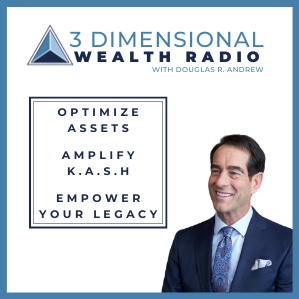Did you know life insurance is technically NOT an investment? Even though you can use it for tax-free retirement income, business capital, educational funds, and more–you can’t call it an investment.
That’s fine, because most investments are subject to tax, penalties, and market volatility–and properly structured, maximum-funded IUL policies are way better than that.
BEFORE IUL EXISTED
Before I dive into the details, let me give you a bit of historical context. The first few years of my career selling life insurance, I was responsible for over 3,000 clients in 13 western states. I also licensed and trained over 1,000 insurance agents. (When I started back in 1974, Indexed Universal Life insurance had not been created yet.)
Our strategy was this: We would sell term insurance and have clients invest the difference automatically. Every dollar they put into this plan, one-third would go toward a term insurance policy. The other two-thirds would go into an annuity that would save money for them–at the time earning about 7.5% to 8.5% interest (which sounds pretty good these days). Most of our clients would assign those annuity values out every 90 days to a mutual fund of their choice. So, it was essentially a way to help our clients “buy term and invest the difference.”
THE CHALLENGE WITH TRADITIONAL INVESTMENTS
Also popular at the time were mutual funds. Now the challenge with mutual funds was this: Even if folks were able to earn, say 12%, in mutual funds, by buying and holding, DALBAR (who studies investor behavior) would say the average investor in the market really only earns about 9.14% before tax. And when they pay tax on it, they’re netting about 6%.
So let’s say folks could average 12% on the market, and they could accumulate a nice $1 million nest egg. When they retired, they could withdraw that same 12% ($120,000) a year without depleting the principal, right?
However, when they pulled out $120,000 a year, they would have to pay tax on that every single year. Between federal and state tax, most Americans pay at least a third of their income in taxes. So, when withdrawing $120,000, they would pay $40,000 in taxes, netting $80,000. Many financial advisors and asset managers charge another 1% management fee on that $1 million, so that’s another $10,000 deducted every year. So, if they were earning 12%, they were really only netting 7%, or $70,000 a year.
Making things more challenging, because the market goes through all kinds of gyrations, most people weren’t really averaging 12%, because they would panic when the market went down and would sell. (In fact, DALBAR says the average retiree with money in the market is only averaging 3.5%, because they’re buying and selling at the wrong times.)
UNIVERSAL LIFE APPEARS
In 1980, E.F. Hutton wondered if there could be an alternate way to help clients manage their money. They recognized that there was only one financial repository that allowed people in America to accumulate their money totally tax free, as noted in Section 72(e) of the Internal Revenue Code. This vehicle also allows people to access money, totally tax-free, under Section 7702. And when they ultimately die, money left in the vehicle blossoms and transfers income-tax-free, under Section 101(a) of the Internal Revenue Code.
What was that financial instrument?
Life insurance.
In 1980, I was a big proponent of “buy term, invest the difference, and when you ultimately have enough money, get rid of the term insurance.” Well, when E.F. Hutton proposed using Universal Life insurance as a financial vehicle, it was a huge aha. I got it. This was like “buy term, invest the difference on steroids.” My 3,000 clients were never happier than when I got them out of the volatile market and into the safety of Universal Life.
Back then, they could put a whole lump sum into their policies all at once. Many of the insurance companies were crediting between 11.75% and 15.5%; I never earned less than 11.75% on my Universal Life policies from 1980 to 1990.
Let’s say back then you were earning 11%, you would have netted 10%. If you had $500,000 in your policy, you could access $50,000 a year, tax-free, because you would be earning 11% while netting 10%, cash on cash.
THE IRS & FINANCIAL INDUSTRY PUSH BACK
The IRS took note of the migration to insurance and went to court against E.F. Hutton. E.F. Hutton won. So then the IRS tried Congress. They essentially said, “We’ve got to change the definition of tax-free insurance, because if you violate these tax citations, it’s going to move over to another section of the code, taxable investments.” Well, most investments are also subject to market volatility.
In 1982, under the Tax Equity Fiscal Responsibility Act (TEFRA), the IRS didn’t quite get it right in Congress. So two years later, they redefined it under the Deficit Reduction Act (DEFRA). Under the TEFRA/DEFRA tax citations, it outlined the minimum amount of insurance that had to be attached to a Universal Life policy. If those requirements weren’t met, the account would violate TEFRA and DEFRA and become classified as an investment, thereby triggering taxes sooner or later, as well as being subject to market volatility.
We were fine with that. We didn’t want insurance to be deemed an investment.
Life insurance is tax-free under Internal Revenue Code Sections 72(e), 7702 and 101(a). With Universal Life insurance, if you earned 11%, you could net 10%. In order to net 10% out of a mutual fund or a tax-deferred IRA or 401(k), you’d have to earn 15% or 16% to net 10%, thanks to the taxes and fees.
There was a massive exodus of money that left the banks and the brokerage firms as Americans moved their money into Universal Life policies. The banks and brokerage firms didn’t like the shift, so they lobbied Congress. They didn’t want to destroy Universal Life policies (because many of them put their own money into them); they just wanted to slow the flow.
So in 1988, under the Technical and Miscellaneous Revenue Act (TAMRA), Congress made another change. If you wanted to avoid creating a Modified Endowment Contract (and triggering taxes), you had to spread out the funding of your policy over several payments (between four and seven years).
So if you wanted to put, say $500,000, into a Universal Life policy, the most you could put in would be about $100,000 a year. From that point on, you could access the money tax-free, if you did it the smart way (via policy loans).
Since those laws passed, anyone opening a Universal Life policy needs to adhere to the guidelines to avoid violating TEFRA, DEFRA, and TAMRA. If violated, your money is no longer defined as tax-free insurance–it becomes a taxable investment. And since investments typically incur taxes and are subject to market volatility, I don’t want my money deemed an investment.
INDEXED UNIVERSAL LIFE ARRIVES
Now there has been another evolution in life insurance since the 1980s. Indexed Universal Life arrived on the scene in 1997, and I have been one of its biggest proponents ever since.
With traditional Universal Life insurance, your money in the policy is safe, earning the General Account Portfolio rate, let’s say that’s 4% or 5%. But with Indexed Universal Life, you can harness the power of indexing, which means your money can be LINKED TO the market while not at risk IN the market. You can link to an index any year you want. And you’re protected by a 0% floor during market downturns.
Let’s say you have $1 million dollars of cash value in your properly structured, maximum-funded IUL policy (what I call an IUL LASER Fund). You can choose to earn the GAP rate, let’s say, of 4%, which in this example would be $40,000. Or you can choose an indexing strategy, telling the insurance company that you’d like to link it to an index, say, the S&P 500, the Dow Jones, or the Russell 2000. You can also diversify among several indexes.
When you do this, you are not authorizing the insurance company to take one dime of your $1 million and put it at risk in the market. You’re actually relinquishing the GAP interest on your money (the $40,000), and you’re allowing the insurance company to use that money ($40,000 in this example) to buy upside options in the index(es) you choose.
If the market goes up, that gives the insurance company the wherewithal to pay you the current rate, say 8% or 12%. The insurance company can afford to do that, because they buy options with the interest on your money. If the market crashes, those options expire worthless, but you don’t lose the million you started with. You simply gave up the GAP 4% that year, and you’re protected by a 0% floor. This is how it’s possible to benefit from the upsides of the market while being protected from the downsides.
BETTER THAN AN INVESTMENT
With these kinds of advantages, you can see why I don’t want my IUL LASER Fund to ever be deemed an investment. Properly structured, maximum-funded IUL policies are not investments, and you should never purchase them as an investment.
They’re way better than most investments:
- They’re not subject to market volatility
- Your money can grow tax-free
- You can access your money tax-free
- You can pass along your money to your heirs income-tax-free
- You can enjoy liquidity, safety, predictable rates of return, and tax advantages
Yep, way better than an investment.
WANT TO LEARN MORE?
Watch the Video – Watch the related YouTube video to see me explain “Why Life Insurance Is Not an Investment | It’s Way Better than That” (and while you’re there, be sure to subscribe to my YouTube channel so you don’t miss a thing!).
Elevate Your Financial Dimension – Find out how you can improve your Financial Dimension journey and seize the liquidity, safety, predictable rates of return, and tax advantages of a LASER Fund. Explore the in-depth financial strategies and learn from real-life client experiences by claiming your free copy of “The LASER Fund” book at LASERFund.com. Just pay for shipping and handling, and we will send it to you, absolutely free.
Join a Webinar – Want to find out if a LASER Fund (a maximum-funded, properly structured indexed universal life insurance policy) is right for you? Join us for an upcoming webinar where you can explore these strategies.


